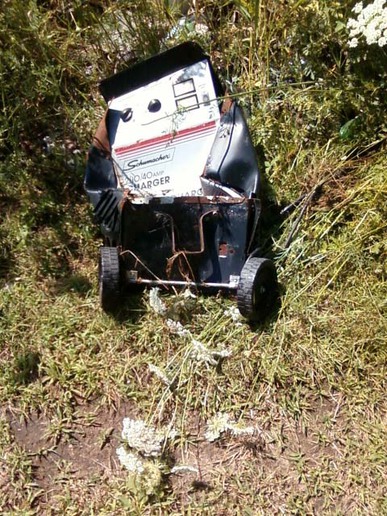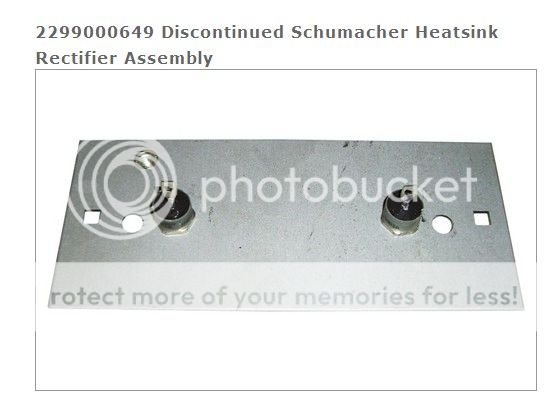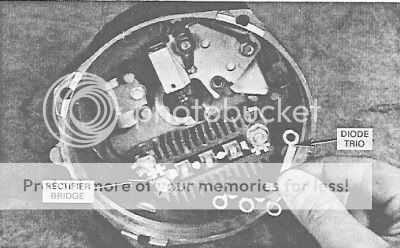Well I finally got around to opening them both up. Both SE2001 models. Both have bad diodes in them. One puts out voltage but is 12 volts AC funny how a meter will not read AC on the DC scale. The other one also has bad diodes but those are burned out as in open the other the diodes are shorted out. Will be checking there web site in a few to see how much the diodes might be for both or them
You are using an out of date browser. It may not display this or other websites correctly.
You should upgrade or use an alternative browser.
You should upgrade or use an alternative browser.
- Thread starter old
- Start date
I know I could probably take the numbers off the ones in the charger and match them to something at radio shack that would work but prefer to get what the company used so as to maybe be closer to correct. Odd how one charger has them shorted and the other has them open
ShadetreeRet
Well-known Member
About two years ago I bought a small 6/12 Schumacher charger from TSC, had a two year warranty.Paid less than $30.00.
Thing quit working so I called TSC and was told that if something under warranty quit the first year they generally took care of it at the store, but since it was over a year old I would have to deal with the factory. Well, shucks, it would probably cost me $10.00 or more to ship it to them. Checked it out myself. Both 6 and 12 were putting out, problem seemed to be in selector switch,looked that up and they wanted $13.00 for that! Guess I will toss it in the corner with all that other stuff that "I'm gonna fix someday".
Thing quit working so I called TSC and was told that if something under warranty quit the first year they generally took care of it at the store, but since it was over a year old I would have to deal with the factory. Well, shucks, it would probably cost me $10.00 or more to ship it to them. Checked it out myself. Both 6 and 12 were putting out, problem seemed to be in selector switch,looked that up and they wanted $13.00 for that! Guess I will toss it in the corner with all that other stuff that "I'm gonna fix someday".
Geo-TH,In
Well-known Member
Old, is it possible to rob some diodes out of an old alternator? I remember the old chrysler alternators, there were 6 diodes pressed in. The way I look at it, you could double up and use two diodes side by side, parallel, and it won't hurt a thing. My mig welder came with 4 diodes, 2 sets in parallel. When one side burnt out two diodes, I replaced them with 3 diodes in parallel.
I've never spent money on diodes. Have a box full of used ones.
George
I've never spent money on diodes. Have a box full of used ones.
George
Brad Buchanan
Member
Hey Rich!
Can't figger out why this Schumacher machine doesn't work..
Was fine until the wife ran it down with the bucket truck.
Brad

Can't figger out why this Schumacher machine doesn't work..
Was fine until the wife ran it down with the bucket truck.
Brad

Geo-TH,In
Well-known Member
Old, All the chargers I've seen use only 2 diodes and a transformer that has a center tap. The output, if seen on an oscilliscope, are postiive 1/2 waves. It is still considered a full wave power supply, because there are 120 + waves per second.
Old go to http://en.wikipedia.org/wiki/Rectifier
About half way down is what I copied below. I wasn't able to copy the diagrams. As stated below, there are two ways to make full wave power supplies. The second one is what chargers use, 2 diodes and transformer with center tap.
Full-wave rectification
A full-wave rectifier converts the whole of the input waveform to one of constant polarity (positive or negative) at its output. Full-wave rectification converts both polarities of the input waveform to DC (direct current), and yields a higher mean output voltage. Two diodes and a center tapped transformer, or four diodes in a bridge configuration and any AC source (including a transformer without center tap), are needed.[2] Single semiconductor diodes, double diodes with common cathode or common anode, and four-diode bridges, are manufactured as single components.
Graetz bridge rectifier: a full-wave rectifier using 4 diodes.For single-phase AC, if the transformer is center-tapped, then two diodes back-to-back (cathode-to-cathode or anode-to-anode, depending upon output polarity required) can form a full-wave rectifier. Twice as many turns are required on the transformer secondary to obtain the same output voltage than for a bridge rectifier, but the power rating is unchanged.
Full-wave rectifier using a center tap transformer and 2 diodes.
Full wave power supply
Old go to http://en.wikipedia.org/wiki/Rectifier
About half way down is what I copied below. I wasn't able to copy the diagrams. As stated below, there are two ways to make full wave power supplies. The second one is what chargers use, 2 diodes and transformer with center tap.
Full-wave rectification
A full-wave rectifier converts the whole of the input waveform to one of constant polarity (positive or negative) at its output. Full-wave rectification converts both polarities of the input waveform to DC (direct current), and yields a higher mean output voltage. Two diodes and a center tapped transformer, or four diodes in a bridge configuration and any AC source (including a transformer without center tap), are needed.[2] Single semiconductor diodes, double diodes with common cathode or common anode, and four-diode bridges, are manufactured as single components.
Graetz bridge rectifier: a full-wave rectifier using 4 diodes.For single-phase AC, if the transformer is center-tapped, then two diodes back-to-back (cathode-to-cathode or anode-to-anode, depending upon output polarity required) can form a full-wave rectifier. Twice as many turns are required on the transformer secondary to obtain the same output voltage than for a bridge rectifier, but the power rating is unchanged.
Full-wave rectifier using a center tap transformer and 2 diodes.
Full wave power supply
Geo, yes I do understand a good bit about electronics I have forgotten a good bit more then many people ever did learn about electronics. But then I was a Navy E.T. and did computer repair many years ago. I learned to hate electronics over the year. Still remember an odd thing happening when I was playing with a short wave radio and heard a broadcast of JFK getting shoot but what makes it odd is that it was years after the fact but it seemed to be one from the day it happened.
fixerupper
Well-known Member
Heck a little time with a big hammer and block of hardwood and it'll be back in shape. The dials and gauges aren't broken.LOL The neighbor had one that looked about like that when it met the same fate. They just threw it in the hole and buried it. Jim
pete black
Well-known Member
the old adage applies here: if you can't fix it with a hammer then you have an electrical problem.
Look like this? If not, how differ?(quoted from post at 15:40:03 01/26/13) I stopped at O'Reilly's and looked in there books and all we found was special order stuff so guess I'll pull one out and take it with me to radio shack

Yep, pulled a diode and it has theses numbers and name.
EDAL F7C3 9417.
Tried to call radio shack but guess they where closed already. I also looked at an old Dodge alternator I have out in the junk pile but the diodes in it are way different so that is a not go as for working or mounting. Guess while I am at it I should bring in those 3 or 4 small chargers I have and play with them and see what is wrong with them while I am doing chargers so maybe I will have a charger on hand for say 50% of the batteries I have LOL
EDAL F7C3 9417.
Tried to call radio shack but guess they where closed already. I also looked at an old Dodge alternator I have out in the junk pile but the diodes in it are way different so that is a not go as for working or mounting. Guess while I am at it I should bring in those 3 or 4 small chargers I have and play with them and see what is wrong with them while I am doing chargers so maybe I will have a charger on hand for say 50% of the batteries I have LOL
I know where that is at. Had a break down back in July of 1980 when the IH pick up I was towing behind my 68 Dodge charger lost a rear wheel. I did go out and look at a couple dodge alternators I have but the diodes in them look way different so those do not look like they would work. Also stopped at O'Reilly's and looked in the book for diodes and all that I found that might be close where special order things
Geo-TH,In
Well-known Member
Old,
Can you post a pic of the inside of your charger? I'll check what I have in my box of used diodes. I think the last time I replaced diodes in the manual charger I purchased 44 years ago, I used two diodes in a square metal package. Just have to get the right combo. Have to scratch my head and figure out if connect the two out wires from the transformer to cathodes or anodes.
George
Can you post a pic of the inside of your charger? I'll check what I have in my box of used diodes. I think the last time I replaced diodes in the manual charger I purchased 44 years ago, I used two diodes in a square metal package. Just have to get the right combo. Have to scratch my head and figure out if connect the two out wires from the transformer to cathodes or anodes.
George
The diode that cam out is a EDAL F7C3 9417 The solder on part is the wide end of the V and the bolt on heat sink part is the + end. Hope that explains it correctly and in a way you understand. Been to many years since I did much in Electronics to remember which end is which as in the correct terms. By the way it is about as big around as a persons index finger. Below the big part is an area for a wrench and a 17MM wrench is just small enough not to fit
id you look at the link that I posted????????!!!(quoted from post at 13:40:30 01/27/13) The diode that cam out is a EDAL F7C3 9417 The solder on part is the wide end of the V and the bolt on heat sink part is the + end. Hope that explains it correctly and in a way you understand. Been to many years since I did much in Electronics to remember which end is which as in the correct terms. By the way it is about as big around as a persons index finger. Below the big part is an area for a wrench and a 17MM wrench is just small enough not to fit
liff, that depends on how the paralleled diodes are matched. Chip makers even sell matched diodes exactly for this purpose. I have successfully paralleled as many as 5 matched diodes, all sharing current within 10%. Found often it welders. Even if you don't buy matched sets, simple selection will get you close enough for home projects. Their very nature makes them want to share, i.e., as current goes up in one, so does its voltage drop (particularly in the intrinsic materials), so that results in the other diode (which had the higher initial junction drop) taking on more current.......not as perfect as matched sets, but still sharing. If you parallel a 1 amp diode with a 100 amp diode, they will not share very well!(quoted from post at 10:09:46 01/28/13) George,
Diodes do NOT work well in parellel. One will carry all the current and the other will carry none.
Cliff(VA) EE
OK, then..pull the rectifier bridge assy (6 diodes with heat sink) out of one of your junkyard Delco 10-SI units and wire up 2 of the 6 diodes.(quoted from post at 00:43:13 01/28/13) Yes and I think I also book marked it but right now $12 for each is a bit to much for me LOL

JMOR,
You and I have had this argument before. And I agree that matched diodes will share current to a degree.
But most on this board do not know how to match diodes or even that they need to be matched. It can make for some explosive fun.
Unless you know what you are doing, either buy matched diodes or don't parellel them.
Cliff(VA)
You and I have had this argument before. And I agree that matched diodes will share current to a degree.
But most on this board do not know how to match diodes or even that they need to be matched. It can make for some explosive fun.
Unless you know what you are doing, either buy matched diodes or don't parellel them.
Cliff(VA)
"Unless you know what you are doing..." very important to nearly any undertaking! :wink:(quoted from post at 13:30:28 01/28/13) JMOR,
You and I have had this argument before. And I agree that matched diodes will share current to a degree.
But most on this board do not know how to match diodes or even that they need to be matched. It can make for some explosive fun.
Unless you know what you are doing, either buy matched diodes or don't parellel them.
Cliff(VA)
Similar threads
- Replies
- 13
- Views
- 571
We sell tractor parts! We have the parts you need to repair your tractor - the right parts. Our low prices and years of research make us your best choice when you need parts. Shop Online Today.
Copyright © 1997-2024 Yesterday's Tractor Co.
All Rights Reserved. Reproduction of any part of this website, including design and content, without written permission is strictly prohibited. Trade Marks and Trade Names contained and used in this Website are those of others, and are used in this Website in a descriptive sense to refer to the products of others. Use of this Web site constitutes acceptance of our User Agreement and Privacy Policy TRADEMARK DISCLAIMER: Tradenames and Trademarks referred to within Yesterday's Tractor Co. products and within the Yesterday's Tractor Co. websites are the property of their respective trademark holders. None of these trademark holders are affiliated with Yesterday's Tractor Co., our products, or our website nor are we sponsored by them. John Deere and its logos are the registered trademarks of the John Deere Corporation. Agco, Agco Allis, White, Massey Ferguson and their logos are the registered trademarks of AGCO Corporation. Case, Case-IH, Farmall, International Harvester, New Holland and their logos are registered trademarks of CNH Global N.V.
Yesterday's Tractors - Antique Tractor Headquarters
Website Accessibility Policy

